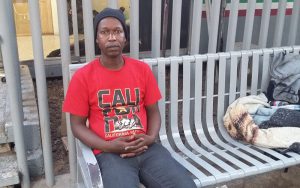- Slug: Haitians in Mexico. 540 words.
- Video story available
- Photo available (thumbnail and caption below)
By ALEJANDRO BARAHONA
Cronkite News
NOGALES, MEXICO – At this busy border crossing, Wilmer Salomon waited with a dozen other Haitian people to put his name on a list for an appointment with U.S. immigration officials.
Mexico has served as a liaison for desperate Haitians trying to reach the U.S. There are at least 4,000 Haitians in San Diego, according to humanitarian organizations. In Nogales, more than 160 Haitians have signed up for appointments with U.S. authorities, according to a Mexican immigration official.
“I know getting to the United States won’t be easy, but only then I’ll be satisfied,” Salomon said in French. Back in Haiti he worked as an auto mechanic but struggled to provide for his wife and two children. So Salomon left for Brazil in 2015 and planned to send money back to support his family. Brazil offered legal residency to 50,000 Haitians after the 2010 earthquake.
But when Salomon arrived in Brazil he could only find odd jobs doing construction work. He and some friends got together and decided it was time to head for the U.S. They are among thousands who have arrived at the U.S. border hoping to qualify for Temporary Protective Status. The U.S. government grants TPS to some people who are coping with certain temporary conditions in their home countries including “an environmental disaster” such as an earthquake or hurricane. Haiti suffered both an earthquake in 2010 and Hurricane Mathew in October.
“In recent months we’ve seen an influx of Haitian nationals on our southern border, principally at certain land ports of entry,” said Jeh Johnson, U.S. Secretary of Homeland Security in a statement about the situation on the border released October 17.
Johnson also said that deportation flights to Haiti that were temporarily suspended because of Hurricane Matthew would resume as soon as possible.
“Haitians attempting to enter the United States without authorization will continue to be placed into immigration detention,” Johnson said.
“Haiti is still the poorest country in our hemisphere,” said Marla Conrad, volunteer coordinator for the Kino Border Initiative. “They just had a hurricane. The infrastructure, they’re not able to take care of the people already in the country much less the people who have been living many years outside the country and have nothing to go back to.”
Conrad said humanitarian groups began to see hundreds of Haitians in Tijuana in May 2016, but because of long waits to see U.S. immigration officials, people began to migrate to other Mexican border cities, including Mexicali and Nogales.
“Haitians have had to sleep on the street for a month, two months. The U.S. is accepting fewer numbers so they can’t enter in as quickly,” Conrad said.
A Mexican immigration officer at the Nogales port of entry said in the past month, only six men have been allowed to cross the border. The majority of those given permission to enter the U.S. have been women and children.
Haitians like Salomon who are stuck in Mexico hope they’ll get the chance to start a new life in the U.S. He’s been waiting more than two months to make his case with U.S. immigration authorities so he can reach his ultimate destination.
“I’m going to Florida because I have family there in the U.S.,” Salomon said.
^__=
